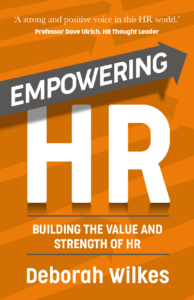Transformation is a BIG word. How could this possibly apply to the Human Resources function? Especially if you’re applying the same expertise and your desk doesn’t move. We can learn from some research by KPMG on HR transformations that don’t work:
‘The common characteristics for failure of HR initiatives were:
organizations not changing roles or structure consistent with their transformation (85 percent),
not identifying measures for success (90 percent) and
having moderate to no change management capabilities (75 percent).’
Reading between the lines there seems to be a theme – the plan wasn’t thought through to its implementation at the front line by the HR people themselves. So, to what extent is this kind of change done to HR? The complexity of HR tends to be continually under-estimated. The human factor is far more sensitive than in the transformation of other functions.
However, the data gives real insight. Put more simply, organisations failed to pay attention to:
- Changing how HR people operate
- Being clear about what they’re trying to achieve
- Developing the skills and behaviours that help HR to implement change and make it stick.
Running throughout these is one red thread – how HR people interact with the business. This is what we researched – what does good interaction between HR and line managers look like? What activities and behaviours lead to great HR outcomes?
First, let’s look at what we mean by HR Transformation
Transformation means a shift from model A to model B during a set period – ie. it will look, feel and perform quite differently and will deliver different outcomes. On the other hand, change is more about moving from A to A+; ie. more effective but essentially the same. Typical themes include organisations transforming HR from reactive to proactive, from ivory tower to customer-centric, and from expertise-led to business-led. The need may come from a change in business strategy – if your whole organisation is making a major shift, then HR must too. We’ve also spoken to many HR people who themselves want to achieve the transformation – they want to add greater value, enhance their reputation, get less hassle and more co-operation.
What are the elements of HR Transformation?
In an ideal world, HR strategy, organisation structure, operational processes and transactional systems would all be redesigned. You’d have sufficient budget, leadership, co-operation, IT support, time and resources to tackle all of these at the same time. This is where the big consultancies come in, to orchestrate the multiple elements of a strategic change programme. The research above, however, shows that the full involvement of HR is often left out. Had the HR people been involved early, and fully engaged and supported, those three failures would have been rectified.
Transformation in the real world
The plan for a transformation can look like a game of chess when you’re sitting in the boardroom. You can see where the pieces are, and where they could move to. However, the world doesn’t stand still for long enough for this kind of plan to be sufficient. Real life tends to be much more messy and unco-ordinated, with everyone too busy rushing around with business-as-usual. This is another feature of HR that’s often underestimated – the relentless demands. It’s hard to pay sufficient attention to ensuring that radical change takes place when you’re stuck in the reactive cycle that you’re trying to get out of.
How successful is this kind of redesign anyway? Research shows that the results are disappointing. For example, a popular approach for many years has been the Business Partner model advocated by Dave Ulrich. It makes so much sense – HR practitioners working closely with their client groups rather than from their ivory tower. However, Ulrich himself tells us that this has failed to achieve its potential, and is clear that this is because it’s the relationship between HR and the business that needs to change.
It isn’t about structure. It’s about behaviour.
Let’s take a closer look at this example. Re-structuring HR into Business Partners works well on paper. It’s easy to see how the the organisation chart changes – we move HR roles from the HR function into ‘client’ departments. Their HR budgets may also move with them, and ideally HR and the line would plan activities together. Experience shows, however, that it can be even harder for HR practitioners to become ‘transformational’ in that structure. Without the right behavioural strategies they can be pulled into a reactive cycle that’s frustrating and damaging to HR’s reputation. It’s exhausting and demoralising, especially if their HR leaders and colleagues are all resigned to the same spiral.
Transformational Intent
So, let’s look at ‘transformational’ in a different way. What if it were about transforming attitude and behaviour? You’d have to change it on both sides, ie. within HR as well as with colleagues ‘in the business’ in order for it to achieve real change. We know, however, that we can’t change the behaviour of others, only our own. This is why Intent is so important.
What do you want the impact of a particular interaction to be? To reinforce your current way of operating, or to lead into a new way of being?
Short-term v long-term dynamic – this is often the nub of the choices you are making from day to day. The pressure is most often to do the most expedient thing. Get the job done, get the tick in the box, get them off your back, move onto the next thing. But this is transactional – ie. it moves nothing forward. There are many occasions when this is the most efficient thing to do.
However, you will sometimes recognise, or be able to create, an opportunity to do, or say, something that will take you forward into a different place.
Transformation can happen conversation by conversation
This is the opportunity that exists for everyone. Most of us don’t operate within a well-orchestrated, cohesive strategic change programme. We can, however, decide upon our own Intent. For example, ‘I want to transform my relationship with this manager.’ If we decide upon this is an HR function or an HR team, it becomes even more powerful: ‘we will transform the way we interact with the business’. If everyone in HR is having a new kind of conversation with their line counterparts, they will soon start to feel some traction.
Intent drives behaviour. It takes courage and determination, and skill too.
HR can lead their own transformation
Once you’ve decided, together, that you want to make a transformational shift, you can begin to work through all the implications. For example:
- How do we make sure we understand the business realities and challenges and how we should respond?
- How can we be seen to understand the business and be seen to respond effectively?
For each organisation the steps required will be different, but you can work them through together. Then you can use techniques like Advocacy and Inquiry to help you have the right kind of conversation – watch out for a future blog on this.
A structure for transformation in HR
We designed enable-hr to provide a framework of the behaviours and activities that underpin success in HR. Explore our 7 Enablers below – there’s a short read and a longer read in each one, with some questions that you might find useful to your own situation.
From our own experience in HR, we understand the complexities and all the different angles involved in the HR role. We’ve also worked with leaders and managers in all functions for over 20 years so we understand the other side too. There are some powerful techniques that we can help you to apply to your own challenges. Call us if you’d like to discuss further. Alternatively, go straight to our Self-evaluation Tool. This can also be used as a 360-degree Feedback Tool for use by stakeholders. Our Team Workshops bring your HR Team together to re-align and re-focus.


